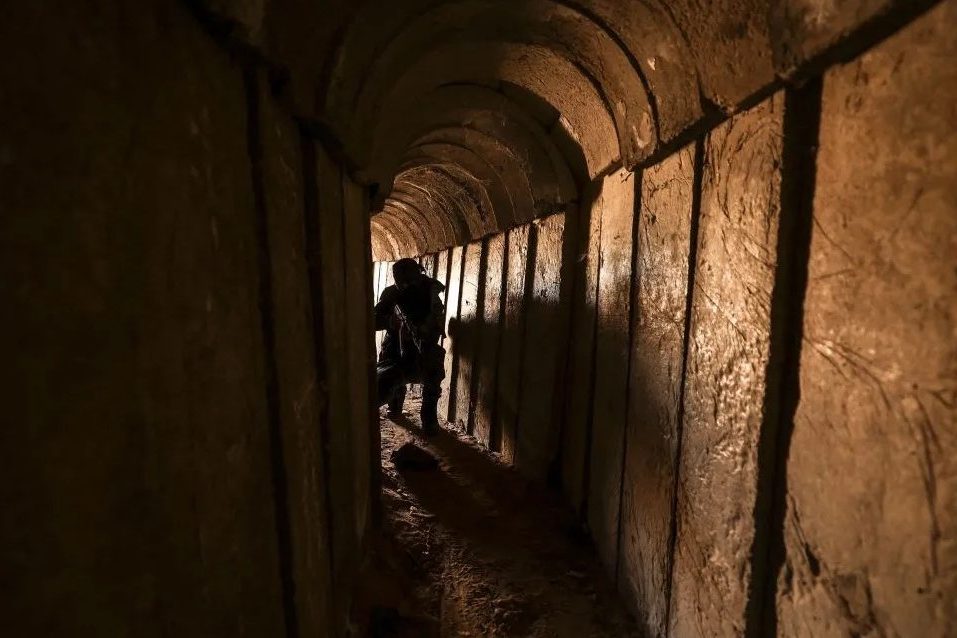Tunnel fighting has always been a problem. As Israel battles in Gaza against some 5,000 Hamas fighters embedded in buildings, ruins and 300 miles of tunnel, it seems an appropriate moment to look at the history of tunnel warfare and its difficulties.
Jewish history is not unfamiliar with the fighting of defensive wars in tunnels. In the third leg of the Roman-Jewish war, known as the Bar Kokhba revolt, the Jewish rebels built an extensive network of tunnels in greater Judea. To date archaeologists have unearthed underground hideout systems in 140 Jewish villages. Eventually, after four years of fierce fighting and the sending of Roman legions from as far away as Galicia, the Jewish resistance was smoked out of its hideouts.
The Roman historian Lucius Cassius Dio, in book 69 of his History of Rome, wrote,
Nine hundred and eighty-five of their [Judea’s] most famous villages were razed to the ground. 580,000 men were slain in the various raids and battles… Thus nearly the whole of Judaea was made desolate.
;768:[300×250,336×280,320×100];0:[300×250,320×100,320×50]”]Given that the population of Judea in the second century is estimated at up to 900,000 people, it would be fair to describe the Roman actions as genocidal — tactics not available to Israel’s Jewish state today.
Neither does the twentieth century history of warfare give much encouragement about the ease of fighting in tunnels. In World War Two, at the start of Operation Barbarossa, while German troops invaded Poland, their Rumanian allies invaded Ukraine. After a four-month battle, the Black Sea port of Odessa fell in October 1941. Over the next three months German Schutzstaffel (SS) groups rounded up 85,000 Jews and executed them. Despite these genocidal massacres, Ukrainian partisan groups, which included Jewish fighters, continued to successfully resist the Axis forces. They occupied and developed defense facilities built into catacomb tunnels which extended into the suburbs of Odessa.
The tunnels, which I visited in Nerubayske, a village on the outskirts of Odessa, are remarkable, not only for their depth, up to twenty meters, but also for their sophistication. As well as providing housing, kitchens, bakeries, hospitals, armories and repair shops, the tunnels were designed with defensive mechanisms that thwarted Nazi penetration. Even the SS’s use of gas, in contravention of the 1925 Geneva Protocol, failed to extract them. Meanwhile the partisans, using hidden exits, harried the occupying Nazis forces with guerrilla attacks throughout the war.
Even when tunnel fighters were defeated in the second world war, the cost in life was horrendous. At Iwo Jima, a US force of 110,000 troops, with a five to one numerical advantage, suffered 27,000 casualties, including 6,100 killed. The battle lasted for 36 days. Most of the casualties were inflicted on the approaches and slopes of Iwo Jima’s Mt Suribachi which Japan’s General Tadamichi Kuribayashi had turned into a fiendish, tunnel-riddled killing machine.
It did not help that during the Pacific war, Japan’s military developed a death cult every bit as fanatical as Hamas. Kuribayashi instructed his troops, “Once the enemy invades the island every man will resist until the end, making his position his tomb.” Like the Hamas terrorist who reportedly called his Palestinian mother on October 7 to boast of killing ten Jews, at Iwo Jima Kuribayashi exhorted the Japanese soldier to “do his best to kill ten soldiers.”
;768:[300×250,336×280,320×100];0:[300×250,320×100,320×50]”]Mt. Suribachi’s caves, machine gun emplacements and hidden hatches were connected by a maze of tunnels; as US corporal Glen Buzzard recalled, “guns would fire from holes dug into the mountain…these would immediately be covered to prevent American artillery getting bearings on their position.” Each of the hundreds of entrances had to be neutralized using grenades or flame throwers.
Ultimately it was the gruesome defense of Iwo Jima and the similarly defended island of Okinawa that formed the basis of casualty statistics used to forecast the one million American fatalities expected from Operation Downfall, the planned invasion of mainland Japan.
The result was that Japan’s cruelly brilliant tunnel defense of Iwo Jima and later Okinawa, made President Harry Truman’s decision to use the atom bomb, as a means of ending the war, a no brainer.
The limitations involved in fighting terrorist guerrillas in tunnels is perhaps best illustrated by the Vietnamese war. Networks of tunnels were constructed by the Viet Cong throughout South Vietnam. Even when tunnels were identified they were difficult to destroy. When the Cu Chi tunnel network was discovered close to Saigon in 1966, US Forces launched Operation Crimp to destroy them. An opening B-52 bomber attack deforested the area but achieved little else. The tunnels and the Vietcong weapons stashes, bunk rooms, repair shops, and canteens were barely harmed. Even when they found the entrances, US foot soldiers were naturally averse to crawling through tunnels that were tight even for wafer thin Viet Cong troops. Intense heat, insects, snakes and boobytraps awaited.
When I arrived in Saigon on Christmas Day 1986, shortly after Doi Moi, Vietnam’s version of the Soviet Perestroika, I even balked at going down the Cu Chi tunnels that had been specially widened for foreigners like me. Claustrophobia won out. Although the US Army would eventually develop specialist units of “tunnel rats” the problem of combatting Viet Cong’s underground infiltration was never solved.
The five examples of tunnel warfare described should give little comfort to the IDF’s forces as they begin the invasion of Gaza. While three of these “tunnel battles” ended with somewhat pyrrhic victories for the attackers, on two occasion the tunnelers were never defeated.
;768:[300×250,336×280,320×100];0:[300×250,320×100,320×50]”]Tunnels are indeed perfect for the asymmetric conduct of war. Even if the defenders lose, the cost of breaking down tunnel defenses is stratospheric for the victors in terms of time and manpower as well as expenditure.
For Israel today the situation is even worse. The IDF’s parameters for fighting, given the restrictive nature of its rules of engagement, as well as the impossible to define “proportionality” rules of the Geneva Convention, force it to fight with one hand tied behind its back. Cheryl Hauer, vice-president of Bridges for Peace, has noted that, “An IDF soldier is required to shout at a suspect to halt activities, and then fire a warning shot into the air, only using lethal force in case of a direct threat.” How does this work in a tunnel combat situation?
Moreover, it seems highly likely that Hamas, which for two years prepared so meticulously its terrorist attack on Israel, will have prepared with equal dexterity the defense of its tunnels for an Israeli invasion. Hamas will have already stored up the weapons, food stores and other paraphernalia that go with tunnel warfare.
It seems likely that the IDF, in terms of bombing targets, has already picked the low hanging fruit. In the past two weeks, US supplied “bunker buster” bombs have been targeted at known or suspected entrances to tunnels. As Patrick Bury, a lecturer at Bath University has recently explained, “Explosives have been used against tunnels for over a century, and the bunker busters have been used since Vietnam.”
But going deeper however the problems will increase. Even the new US 30,000-pound GBU-57 bomb, not yet available to the IDF, which is some six times bigger than the standard GBU-28, only penetrates to 100ft. This is ineffective then against Hamas’s deeper tunnels that are reportedly 100 meters underground.
Does the IDF have special weaponry to defeat the Hamas’s deep tunnelers? After the deadly engagements involving house to house, or rather rubble to rubble fighting, have been completed, and IDF troops finally get to the deeper tunnel entrances, what then? Even with Kevlar body armour, night vision and exploratory robots, soldiers are likely to suffer heavy casualty rates from booby trapped tunnels.
The outlook for the IDF is bleak. A war lasting for years, not weeks, is a prospect. Even if Israel has the resources and willpower to suffer the duration and inevitably high level of casualties that a Gaza tunnel war will entail, it remains doubtful whether its western allies will have the resolve to stay the course as the suffering of Gaza’s Palestinian population mounts.
;768:[300×250,336×280,320×100];0:[300×250,320×100,320×50]”]Both Israel and the West face a difficult question; is engagement in a protracted tunnel war in Gaza the optimum strategy to combat Hamas? As the history of the subject shows, from every perspective a tunnel war in Gaza is a high-risk, high-cost proposition.
This article was originally published on The Spectator’s UK website.


























Leave a Reply